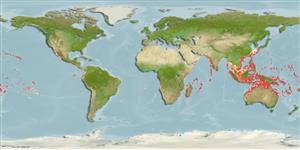Common names from other countries
>
Tetraodontiformes (Puffers and filefishes) >
Monacanthidae (Filefishes)
Etymology: Cantherhines: Greek, kanthos = the outer or inner corner of the eye, where the lids meet, 1646 + Greek, rhinos = nose (Ref. 45335).
Environment: milieu / climate zone / depth range / distribution range
Ecologia
marinhas associadas(os) a recifes; não migratória; intervalo de profundidade 0 - 70 m (Ref. 89467), usually 6 - 35 m (Ref. 9710). Tropical; 32°N - 32°S
Indo-Pacific: East Africa to French Polynesia, north to Japan and Hawaii. Eastern Pacific: Mexico to Colombia (Ref. 9318).
Tamanho / Peso / Idade
Maturity: Lm ? range ? - ? cm
Max length : 38.0 cm TL macho/indeterminado; (Ref. 30573); common length : 25.0 cm TL macho/indeterminado; (Ref. 30573)
Descrição breve
Chaves de identificação | Morfologia | Morfometria
Espinhos dorsais (total) : 2; Raios dorsais moles (total) : 34 - 39; Espinhos anais: 0; Raios anais moles: 28 - 35. Greyish brown to yellowish brown with about 12 vertical dark brown bars; lips whitish; male adults with orange peduncle spines; soft dorsal, anal and pectoral fins pale yellowish; caudal fin orange with dusky rays (Ref. 4421). Sexually dimorphic with males having longer and deeper orange peduncular spines and deeper orange tail and eyes (Ref. 37816).
Inhabit offshore coral reefs usually solitary or in pairs (Ref. 5503, 48637). Common in surface waters around oceanic islands (Ref. 9318). Benthopelagic (Ref. 58302). Shy species, usually retreating quickly into caves or large crevices of the reef (Ref. 48637). Juveniles are pelagic, seen under floating objects (Ref. 9318). Feed on tips of branching corals, algae, sponges, sea urchins, and mollusks (Ref. 1602). Minimum depth reported taken from Ref. 128797.
Life cycle and mating behavior
Maturities | Reprodução | Spawnings | Egg(s) | Fecundities | Larvas
Myers, R.F., 1991. Micronesian reef fishes. Second Ed. Coral Graphics, Barrigada, Guam. 298 p. (Ref. 1602)
Categoria na Lista Vermelha da IUCN (Ref. 130435)
CITES (Ref. 128078)
Not Evaluated
Ameaça para o homem
Harmless
Utilização humana
Warning: mysqli::__construct(): (HY000/1040): Too many connections in /var/www/html/includes/func_getlabel.php on line 46
Can't connect to MySQL database (fbapp). Errorcode: Too many connections
